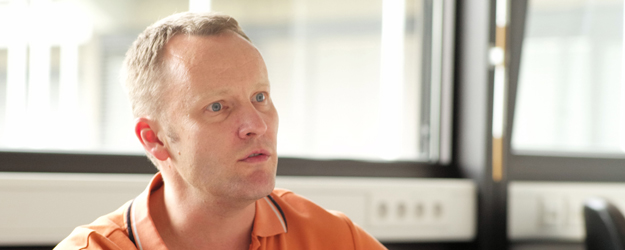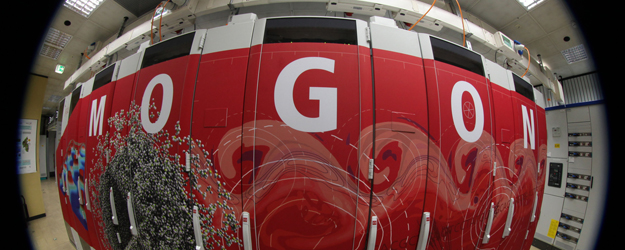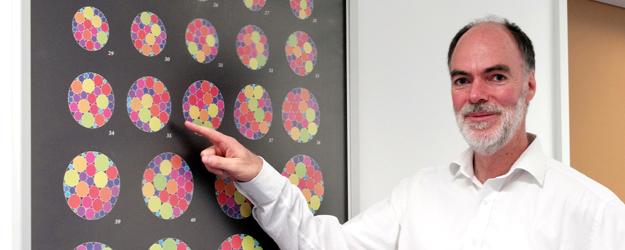17 November 2014
Thirty years ago the first Professor of Computer Science was appointed at Johannes Gutenberg University Mainz (JGU). A lot has since changed in this relatively recent field. This special anniversary is a good reason to take a quick look back, despite the fact that the professors at the Institute of Computer Science prefer to talk about their current work and projects. After all, the present and future are far more interesting to them than a brief history of their discipline.
The large conference table is almost empty apart from a laptop in the center with a cable curling around it. One by one staff members of the JGU Institute of Computer Science filter in, while its current director, Professor Bertil Schmidt, starts the conversation. "We are a young team," says Schmidt. Anybody over 50, he adds, is a true veteran in the field. He then smirks as one such veteran comes through the door: Professor Elmar Schömer. He has set a few world records in his scientific career that have brought him a lot of attention from his colleagues in his profession, the press, and from the builders of drilling platforms. But we'll come to that later.
Dr. Hans-Jürgen Schröder is also one of the older members of staff. As Academic Director of the institute, he is responsible for study management and departmental advisory services. Four young professors then come in after him. "He has the best coffee machine," says Schmidt, grinning in the direction of Professor Andreas Hildebrandt. Hildebrand beams like a big boy at the compliment. "The atmosphere here is very informal," explains the computer scientist with the somewhat unwieldy title of Head of Software and Bioinformatics. The informality is fairly obvious. The mood is relaxed. The scientists then decide to get down to matters and a lively discussion ensues.
The founding father of computer science in Germany
The discipline of Computer Science celebrates its 30th birthday at Johannes Gutenberg University Mainz this year. However, the group around the table is not keen on looking back. "Computer scientists tend to be more interested in the future than the past," says Hildebrandt. "And no wonder in view of the fact that the technology and science in our subject develop so rapidly." So a few highlights will have to do.
"Friedrich L. Bauer taught here in the 1960s," recalls Professor Stefan Kramer. Bauer was Professor of Applied Mathematics for four years in Mainz. "He was one of the founding fathers of computer science in Germany." The first Professor of Computer Science at Mainz, now retired Jürgen Perl, was appointed in 1984. "The institute itself was founded in 1988," explains Schröder. Computer Science started only as a minor subject. Nonetheless, the relevance of the institute also began to grow with the same breakneck speed as computer technology. As Computer Science became increasingly important, the discipline became a major subject. "We were one of the first institutes to launch a Bachelor's degree program in Computer Science," says Schröder. Nowadays, 170 students enroll at the Institute of Computer Science at Mainz University every year.
"With only seven professors, we have remained a relatively small institute," asserts Schmidt. "We believe in maintaining an informal environment here," adds Schömer. "However, we can measure up to the larger institutes in terms of quality and we cover a broad range of methodologies," affirms Hildebrandt. "We have a strong interdisciplinary focus and an enormous number of projects find their way to us." Professor Ernst Althaus confirms this: "We often work together with other disciplines. It is great for us although it requires a lot of energy." – "First of all, we always need to learn the jargon employed by our cooperation partners," explains Krämer. "And we have to understand their objectives."
Research on an informal footing
Work at the institute tends to follow the same pattern as that of meetings. "We develop techniques and software packages designed to support drug development and cancer diagnosis," says Hildebrandt, listing some examples from his area. "We translate things from the medical realm into the mathematical domain. If I need an algorithm, I talk to Ernst." He nods in the direction of Althaus, who is responsible for Theoretical Computer Science. "If I need to speed up the computing, I ask Bertil, and if I need a visualization, I go to talk to Elmar." As Schmidt and Schömer nod, Kramer summarizes: "In our case, all you usually need to do is just bring up a topic and discuss it with your colleagues."
Research in the present day is no longer able to function without computers, without Computer Science. This means that many other disciplines are clamoring to work with the institute and that Professor André Brinkmann, head of JGU's Data Center, who unfortunately could not attend the meeting, works correspondingly close to the center of things. Irrespective of whether the discipline is Philology or Biology, Sports Sciences, Chemistry, or Psychology, computer scientists are always in demand. Schmidt researches genetic sequencing, while Schömer examines the formation of clouds.
Interdisciplinary research
"We are currently working on a project the purpose of which is to analyze the air extracted from a large Mainz movie theater," Kramer says of one unusual cooperation of his work group with the team led by Professor Jonathan Williams at the Max Planck Institute for Chemistry. "Williams and his team are examining the trace gases contained in the air." What do moviegoers exhale when they watch a romance or an action movie? "We have just brought a psychologist on board to help with the evaluation."
MOGON I is working in the background on all these projects. This is JGU's high-performance computer that was acquired in 2012 and extended in 2013. "At the time it was among the top 100 of the 500 fastest computers in the world," says Schmidt. It was ranked eighth in Germany. In the face of the rapid technological developments, MOGON I is likely to have fallen back a few places, but the professors are looking forward gaining a new high-performance machine in 2015, MOGON II.
Hildebrandt tells how difficult it is sometimes to explain to the partners from other disciplines what such a computer can do really well and what its shortcomings are. "Computers and people have completely different abilities and strengths. We need to make it clear what these devices find easy and where they can come unstuck. A human being can easily recognize a cat in a picture but developing a program for a computer to do the same is a real challenge." On the other hand, it is relatively easy for computer programs to scan large quantities of data in order to search for recurring patterns. "At the same time, we still haven't managed to solve the problem of schedule optimization," says Althaus, citing one area of research that is very much all the rage at universities.
A solution to the packing problem
Schömer and his team are focusing on another matter that at first glance does not actually seem that complicated: problems with packing. The media attention was enormous and oil rig builders have benefited. What they were doing was in effect little more than exploring how to best pack luggage in the trunk of a car. Or, to put it in more abstract terms: how do you arrange a certain number of circles so that they will fit best within a single circle of the smallest possible circumference?
Schömer's solutions for the internationally discussed packing problem generated a large amount of attention and broke old world records. "A company that builds oil rigs then came by," says Schmidt. "They needed thick cables and wanted to know how they could best position the various wires within them." Schömer's solutions helped.
The computer scientists have their fingers in a lot of pies, as revealed by the lively discussion. Computer Science has been around for 30 years at Mainz University but it looks like nobody is planning to take the time off to celebrate. Computer scientists are simply more interested in the future - and tons of interesting projects are awaiting the professors and their teams.





